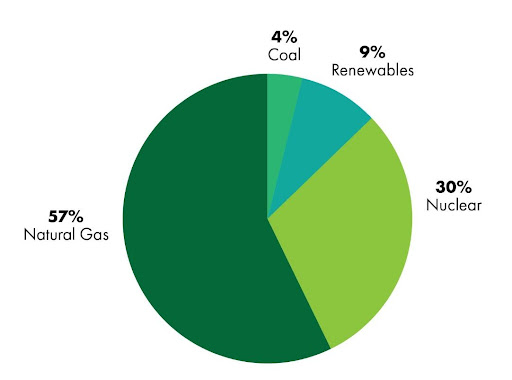About Virginia‘s Energy

Virginia‘s Energy Plan
Virginia’s energy strategy follows an “all of the above” approach that uses nuclear, natural gas, renewable, and new energy sources to fulfill the Commonwealth’s energy needs.
The Commonwealth’s 2022 Energy Plan recognizes the following five principles as part of ensuring energy access for all Virginians:
- Reliability. Ensure that Virginians have access to energy when and where they need it by preserving the reliability of Virginia’s electric grid.
- Affordability. Keep energy affordable and protect Virginians from rising energy prices.
- Innovation. Bring the Commonwealth to the forefront of energy innovation by embracing and incorporating new renewable energy technologies.
- Competition. Provide Virginians with more choices in where their energy comes from.
- Environmental stewardship. Improve the quality of Virginia’s environment and protect the Commonwealth’s natural resources.
Where Your Power Comes From
Do you know where your electricity comes from? In Virginia, electricity is generated from a variety of energy sources, including nuclear, coal, natural gas, hydroelectric, renewable, petroleum, and other sources. According to the U.S. Energy Information Administration, most of Virginia’s electricity is generated from natural gas (57%), nuclear (30%), and renewable (9%) sources. The remainder (4%) comes from coal.

Where Virginians Use the Most Energy
- Heating and cooling. This typically constitutes the largest share of energy usage in homes and workplaces.
- Appliances. Refrigerators, dishwashers, and dryers together account for about 20% of all energy used in homes.
- Water heating. This accounts for about 20% of home energy usage.
- Lighting. Lighting represents the largest share of energy usage in the commercial sector and approximately 15% of the average home’s electricity usage.
- Electronics. Demand in this area is increasing because of advanced computer equipment, more sophisticated televisions and streaming devices, and more.
Virginia’s transportation sector consumes the most energy in the state (30.5% of total usage), followed by the commercial sector (26.8%), residential sector (24.2%), and industrial sector (18.5%).
For more information on the Commonwealth’s energy consumption, see the Energy Information Administration’s Virginia profile.
Demand Response Programs
Rising peak demand can strain the electricity system and potentially hurt the power grid’s reliability. Some energy providers have implemented demand response programs, which give commercial and residential energy consumers incentives to lower their power usage when demand is especially high, such as on a hot summer day.
Demand response improves the overall efficiency of the electricity system (including transmission and distribution) but differs from traditional energy efficiency in that it is more dynamic and controllable, meaning that it can be “dispatched” to meet rising demand in lieu of turning on an additional power plant.
As of January 2023, two of Virginia’s energy providers — Dominion Energy and Appalachian Power — offer demand response programs for consumers. In 2021, Dominion Energy launched the voluntary Off-Peak Plan pilot program, open to customers who use smart meters. These customers can adjust their energy usage during the day to avoid using it during more expensive peak hours and save on their electric bills. The pilot program is limited to 10,000 customers and has reached its limit, but spots will open if current volunteers unenroll.
Other examples of demand response programs include EV Charger Rewards from Dominion Energy and Bring Your Own Thermostat from Appalachian Power. All these programs help ensure an adequate electricity supply and can prevent power outages.
If you’re interested in participating in demand response programs as a residential or commercial customer, check with your energy provider to find out about available programs and whether you’re eligible.